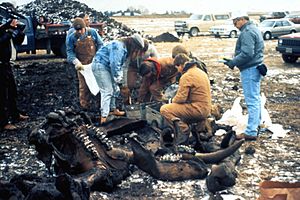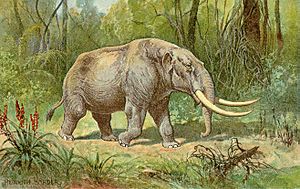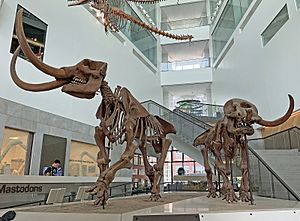Mastodon facts for kids
Quick facts for kids Mastodon |
|
|---|---|
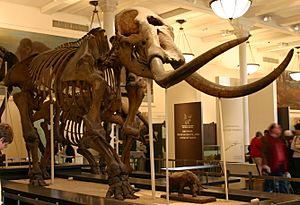 |
|
| Mounted M. americanum skeleton (the "Warren mastodon"), AMNH | |
| Scientific classification |
|
| Unrecognized taxon (fix): | Mammut |
| Type species | |
| †Elephas americanum Kerr, 1792
|
|
| Species | |
| Synonyms | |
A mastodon (mastós 'breast' + odoús 'tooth') is any proboscidean belonging to the extinct genus Mammut. Mastodons inhabited North and Central America from the late Miocene up to their extinction at the end of the Pleistocene 10,000 to 11,000 years ago.
Mastodons are the most recent members of the family Mammutidae, which diverged from the ancestors of elephants at least 25 million years ago.
M. americanum, the American mastodon, and M. pacificus, the Pacific mastodon, are the youngest and best-known species of the genus. They lived in herds and were predominantly forest-dwelling animals. M. americanum is inferred to have had a browsing diet with a preference for woody material, distinct from that of the contemporary Columbian mammoth. Mastodons became extinct as part of the Quaternary extinction event that exterminated most Pleistocene megafauna present in the Americas, believed to have been caused by a combination of climate changes at the end of the Pleistocene and hunting by recently arrived Paleo-Indians, as evidenced by a number of kill sites where mastodon remains are associated with human artifacts.
History
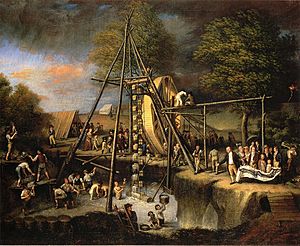
A Dutch tenant farmer found the first recorded remnant of Mammut, a tooth some 2.2 kg (5 lb) in weight, in the village of Claverack, New York, in 1705. The mystery animal became known as the "incognitum".
In 1739 French soldiers at present-day Big Bone Lick State Park, Kentucky, found the first bones to be collected and studied scientifically. They carried them to the Mississippi River, from where they were transported to the National Museum of Natural History in Paris. Similar teeth were found in South Carolina, and some of the African slaves there supposedly recognized them as being similar to the teeth of African elephants.
There soon followed discoveries of complete bones and tusks in Ohio. People started referring to the "incognitum" as a "mammoth", like the ones that were being dug out in Siberia – in 1796 the French anatomist Georges Cuvier proposed the radical idea that mammoths were not simply elephant bones that had been somehow transported north, but a species which no longer existed. Johann Friedrich Blumenbach assigned the scientific name Mammut to the American "incognitum" remains in 1799, under the assumption that they belonged to mammoths. Other anatomists noted that the teeth of mammoths and elephants differed from those of the "incognitum", which possessed rows of large conical cusps, indicating that they were dealing with a distinct species. In 1817 Cuvier named the "incognitum" Mastodon, meaning "breast tooth" (Ancient Greek: μαστός "breast" and ὀδούς, "tooth").
Description

Compared to mammoths and extant elephants, mastodons had a longer and wider body but were not as tall due to their shorter legs. Their limbs were more heavily muscled and had considerably thicker limb bones, making mastodons much more robust in comparison. As in modern elephants, the females were smaller than the males. The average shoulder height for male M. americanum was about 2.9 m (9 ft 6 in) with an average body mass of 8 tonnes (7.9 long tons; 8.8 short tons); large males were up to 3.25 m (10.7 ft) in height and 11 tonnes (11 long tons; 12 short tons) in weight, making them about 80% heavier than modern elephants with equivalent shoulder heights.
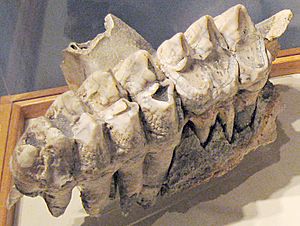
They had a low and long skull with long curved tusks, with those of the males being more massive and more strongly curved. Mastodons had cusp-shaped teeth, very different from mammoth and elephant teeth (which have a series of enamel plates), well-suited for chewing leaves and branches of trees and shrubs. In contrast to its ancestor Zygolophodon, the lower jaw was shortened (brevirostrine), and the lower tusks were vestigial or absent. The lower tusks were present in about a quarter of M. americanum individuals, but seem to have not been present at all in M. pacificus. M. pacificus is also suggested to be distinguished from M. americanum by its narrower molars, its consistent count of 6 sacral vertebrae, as opposed to the typical 5 in M. americanum (though the number in M. americanum varies from 4 to 6), its more robust femurs, and a smaller base male tusk diameter.
Mastodons are typically depicted with a thick woolly mammoth-like coat of hair, but there is no preserved evidence for this, and consideration of the long tail (usually present in animals living in warm climates), size, body mass and environment implies the animal was not similarly hairy, and there is scant preserved evidence of body hair.
Social behavior

Based on the characteristics of mastodon bone sites and strontium and oxygen isotopes from tusks, it can be inferred that, as in modern proboscideans, the mastodon social group consisted of adult females and young, living in bonded groups called mixed herds. The males abandoned the mixed herds once reaching sexual maturity and lived either alone or in male bond groupings. As in modern elephants, there probably was no seasonal synchrony of mating activity, with both males and females seeking out each other for mating when sexually active.
Diet
Mastodons have been characterized as predominantly browsing animals. Of New World proboscids, they appear to have been the most consistent in browsing rather than grazing, consuming C3 as opposed to C4 plants, and in occupying closed forests versus more open habitats. This dietary inflexibility may have prevented them from invading South America during the Great American Interchange, due to the need to cross areas of grassland to do so. Most accounts of gut contents have identified coniferous twigs as the dominant element in their diet. Other accounts (e.g., the Burning Tree mastodon) have reported no coniferous content and suggest selective feeding on low, herbaceous vegetation, implying a mixed browsing and grazing diet, with evidence provided by studies of isotopic bone chemistry indicating a seasonal preference for browsing. Study of mastodon teeth microwear patterns indicates that mastodons could adjust their diet according to the ecosystem, with regionally specific feeding patterns corresponding to boreal forest versus cypress swamps, while a population at a given location was sometimes able to maintain its dietary niche through changes in climate and browse species availability.
Distribution and habitat

The range of most species of Mammut is unknown as their occurrences are restricted to few localities, the exception being the American mastodon (M. americanum), which is one of the most widely distributed Pleistocene proboscideans in North America. M. americanum fossil sites range in time from the Blancan to Rancholabrean faunal stages and in locations from as far north as Alaska, as far east as Florida, and as far south as the state of Puebla in central Mexico, with an isolated record from Honduras, probably reflecting the results of the maximum expansion achieved by the American mastodon during the Late Pleistocene. A few isolated reports tell of mastodons being found along the east coast up to the New England region, with high concentrations in the Mid-Atlantic region. There is strong evidence indicating that the members of Mammut were forest dwelling proboscideans, predominating in woodlands and forests, and browsed on trees and shrubs. They apparently did not disperse southward to South America, it being speculated that this was because of a dietary specialization on a particular type of vegetation.
A 2022 study of ancient (Early Pleistocene, 2 million years ago) environmental DNA from the Kap Kobenhavn Formation of northern Greenland identified preserved DNA fragments of mastodons, assigned to M. americanum. This suggests that mastodons ranged as far north as Greenland during optimal conditions. Around this time, northern Greenland was 11–19 °C warmer than the Holocene, with a boreal forest hosting a species assemblage with no modern analogue. These are among the oldest DNA fragments ever sequenced.
Extinction
Fossil evidence indicates that mastodons probably disappeared from North America about 10,500 years ago as part of the Quaternary extinction event of most of the Pleistocene megafauna that is widely believed to have been a result of human hunting pressure. The latest Paleo-Indians entered the Americas and expanded to relatively large numbers 13,000 years ago, and their hunting may have caused a gradual attrition of the mastodon population. Analysis of tusks of mastodons from the American Great Lakes region over a span of several thousand years prior to their extinction in the area shows a trend of declining age at maturation; this is contrary to what one would expect if they were experiencing stresses from an unfavorable environment, but is consistent with a reduction in intraspecific competition that would result from a population being reduced by human hunting.
On the other hand, environmental DNA sequencing indicates that disappearance of megafaunal DNA in North America correlates in time with major changes in plant DNA, suggesting a key role of climate change. Modeling based on the whole of the proboscid fossil record also suggests climate was the more important factor, though with human hunting imposing a "double jeopardy" on mastodons and their kin.
See also
 In Spanish: Mammut para niños
In Spanish: Mammut para niños


